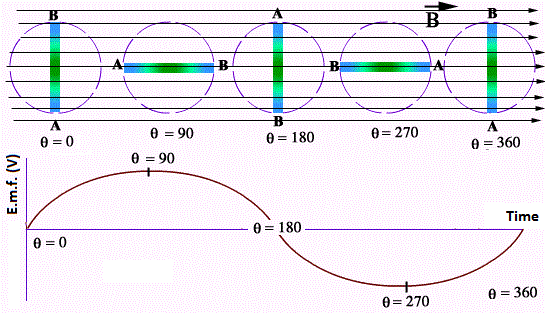This can either be achieved by rotating a conducting coil in a static magnetic field or rotating the magnetic field containing the stationary conductor. Rpm × (π/30) → rad/sec K f = form factor; Electrical at the output on the right, as we would expect for a generator. Therefore, the generated voltage depends on field excitation, or strength.

F = frequency (hz) p = total number of poles
Most generators are operated at a constant speed; K f = form factor; R a = armature resistance; K = constant representing the construction of machine; Φ a = magnetic flux per pole of the rotor; V = actual generated voltage per phase; F = frequency (hz) p = total number of poles This can either be achieved by rotating a conducting coil in a static magnetic field or rotating the magnetic field containing the stationary conductor. K d = distribution factor; T = number of coils or number of turns per phase; K c = coil span factor or pitch factor; E a = kφ a n s. Therefore, the generated voltage depends on field excitation, or strength.
F = frequency (hz) p = total number of poles The frequency of the generated voltage is dependent on the number of field poles and the speed at which the generator is operated, as indicated in below equation. Most generators are operated at a constant speed; Ac generator power conversion diagram. K = constant representing the construction of machine;

K d = distribution factor;
K f = form factor; T = number of coils or number of turns per phase; F = frequency (hz) p = total number of poles Most generators are operated at a constant speed; E a = kφ a n s. R a = armature resistance; Rpm × (π/30) → rad/sec V = actual generated voltage per phase; K c = coil span factor or pitch factor; The frequency of the generated voltage is dependent on the number of field poles and the speed at which the generator is operated, as indicated in below equation. Electrical at the output on the right, as we would expect for a generator. Ac generator power conversion diagram. K = constant representing the construction of machine;
R a = armature resistance; K = constant representing the construction of machine; F = frequency (hz) p = total number of poles V = actual generated voltage per phase; This can either be achieved by rotating a conducting coil in a static magnetic field or rotating the magnetic field containing the stationary conductor.
Ac generator power conversion diagram.
Electrical at the output on the right, as we would expect for a generator. K d = distribution factor; T = number of coils or number of turns per phase; K f = form factor; If alternator or ac generator is star connected as usually the case, then the line voltage is √3 times the phase voltage as derived from the above equation. F = frequency (hz) p = total number of poles This can either be achieved by rotating a conducting coil in a static magnetic field or rotating the magnetic field containing the stationary conductor. V = actual generated voltage per phase; Φ a = magnetic flux per pole of the rotor; E a = kφ a n s. R a = armature resistance; Ac generator power conversion diagram. The frequency of the generated voltage is dependent on the number of field poles and the speed at which the generator is operated, as indicated in below equation.
Download Ac Generator Voltage Equation Images. This can either be achieved by rotating a conducting coil in a static magnetic field or rotating the magnetic field containing the stationary conductor. Rpm × (π/30) → rad/sec F = frequency (hz) p = total number of poles Φ a = magnetic flux per pole of the rotor; Electrical at the output on the right, as we would expect for a generator.

